Lighting has always played a vital role in architecture, and one of the evolving trends in this field is LED Facade Lighting. It’s a dynamic tool that architects and designers use to bring buildings to life during nighttime. Let’s delve deeper into what facade lighting is, its types, how to select it, and its history.
What is Facade Lighting?
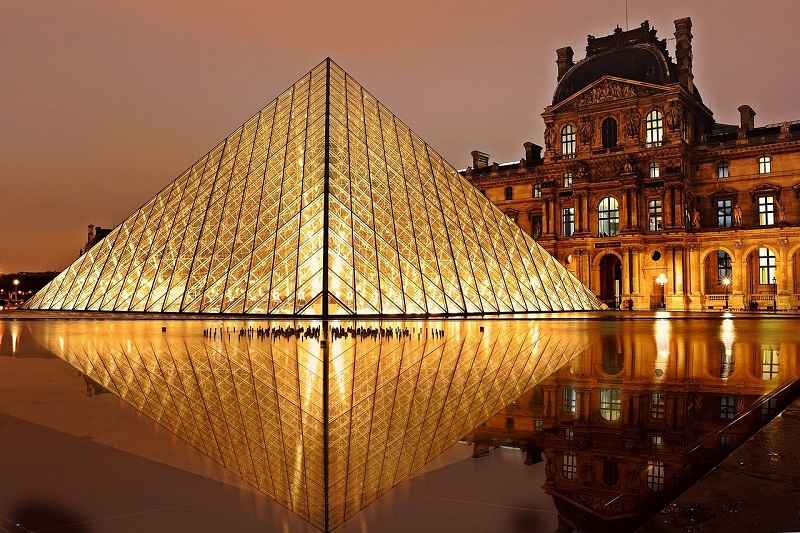
Facade lighting refers to the strategic illumination of a building’s exterior to enhance its architectural features and overall aesthetic appeal, especially during nighttime hours. This architectural lighting method not only emphasizes the unique design aspects of the building but also improves its visibility and contributes to urban ambiance and safety.
LED Facade Lighting, is a recent adaptation in this field. LED lights are known for their superior energy efficiency, longer lifespan, and versatile color range compared to traditional lighting sources.
LED facade lighting employs these characteristics to create dynamic and dramatic lighting effects. This type of lighting allows for a multitude of color options and combinations, which can be programmed to change periodically, thus adding a dynamic visual appeal to the static architecture.
Why LED Facade Lighting?
LED facade lighting offers a range of benefits including enhanced aesthetics, improved safety and security, branding opportunities, cultural celebrations, environmental sustainability, economic impact, and artistic expression. It has become an integral part of urban design, transforming buildings into visual spectacles and contributing to the overall ambiance of cities.
Aesthetics and Visual Impact: Facade lighting enhances the visual appeal of buildings, making them stand out and creating a distinctive identity.
Branding and Identity: Lighting can be used to reinforce a brand or establish a visual identity for a building or organization.
Enhanced Safety and Security: Adequate lighting on building facades improves safety and security by reducing dark areas and shadowy spots around the structure.
Community Engagement and Cultural Celebrations: Facade lighting can be used to celebrate special events and cultural festivals. Iconic buildings often become focal points for public gatherings and create a shared experience for residents and visitors.
Tourism and Economic Impact: Impressive facade lighting installations can attract tourists and visitors, boosting local economies.
Artistic Expression and Creativity: Facade lighting provides a platform for artistic expression and creativity. Lighting designers and architects can experiment with different lighting techniques, colors, and patterns to create visually captivating and immersive experiences.
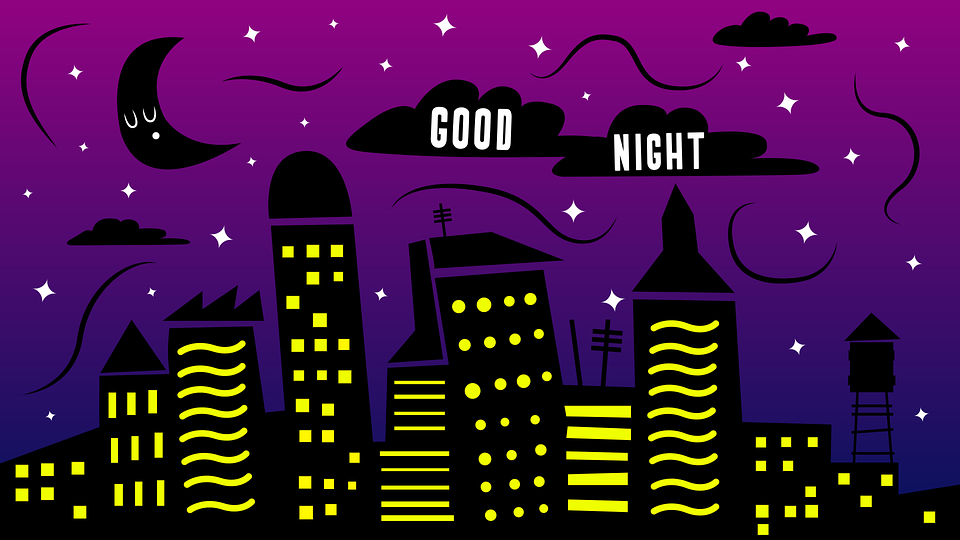
Types of Facade Lighting
Facade lighting comes in various forms, each with its unique effect and application. Here are a few common types:
LED Spotlight
Used in facade lighting to emphasize and draw attention to specific architectural features or elements of a building.
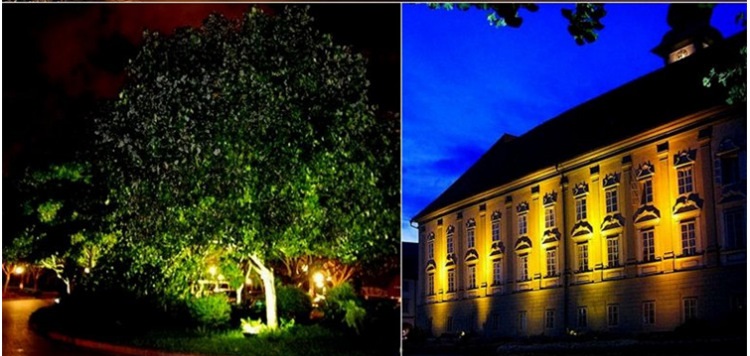
LED spotlights produce a concentrated beam of light, which can be directed toward a particular area or feature. The illumination is often intense and focused, creating a highlighted effect against the darker surroundings. This aspect makes it an ideal choice for showcasing intricate details, unique design elements, or prominent structures in a building’s facade.
It not only enhances the visual appeal of a structure but also offers functional benefits. For instance, these spotlights can be programmed to produce different colors and intensities of light, allowing for a high degree of customization based on specific needs or events. Moreover, due to the energy-efficient nature of LED lights, spotlighting with LEDs also contributes to a significant reduction in energy consumption, making it a sustainable choice for facade lighting.
Wall grazing lighting
Wall grazing lighting is a popular technique in facade lighting used to highlight the texture and details of a building’s surface. This method involves placing LED lights very close to the facade surface, usually at a sharp angle, causing the light to ‘graze’ the surface.
The effect of grazing light creates shadows that accentuate the surface’s textures and details, creating a visually dramatic effect that reveals the building’s intricate design and craftsmanship. This technique is particularly effective on facades with prominent textures or unique architectural features like bricks, stones, or decorative concrete.
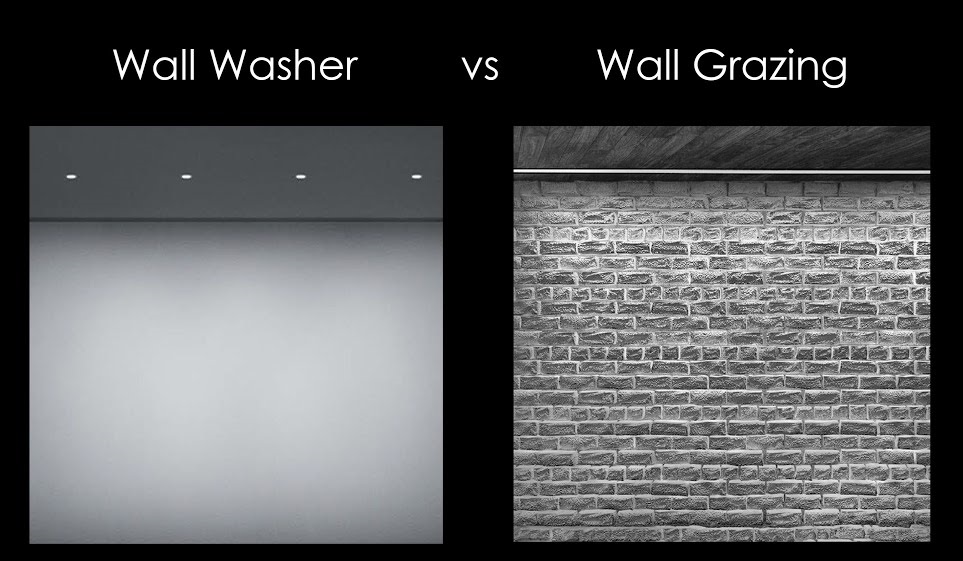
LED Wall Washer Light
LED Wall Washer Light aims to create a smooth and uniform illumination across a building’s exterior surface. By distributing light evenly, this technique ‘washes’ the wall with light, hence the name.
LED Wall Washer Lights are typically arranged in a linear or grid pattern across the facade, with each light carefully calibrated to ensure a consistent level of illumination. This arrangement reduces harsh shadows and contrast, making the building’s surface appear smooth and evenly lit.
One of the main advantages of it is its ability to highlight the overall shape and size of a building rather than focusing on individual features. This makes it particularly effective for buildings with minimalist or modern designs.
LED Cove Lighting
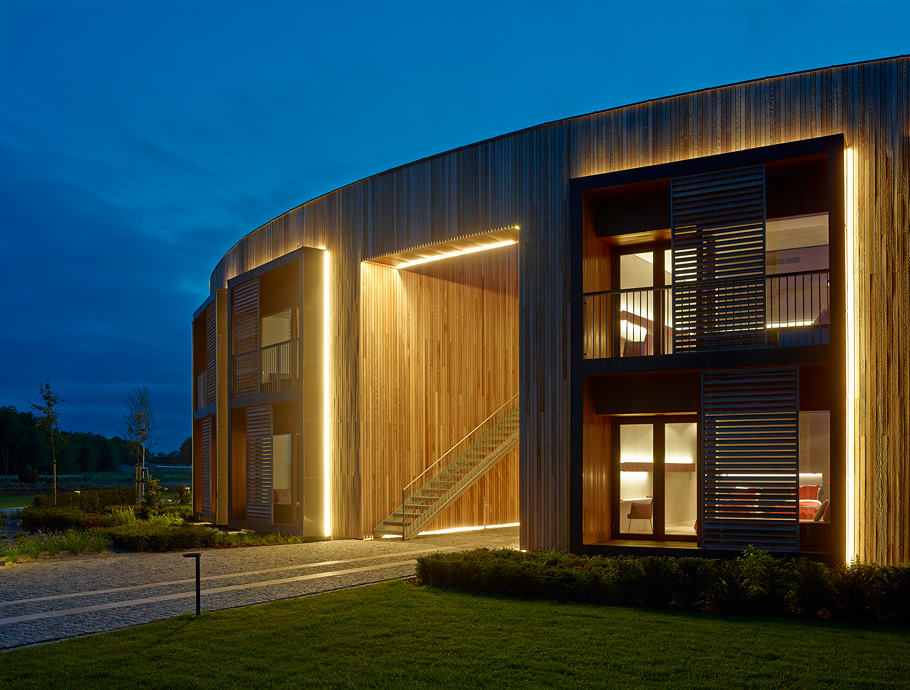
LED Cove Lighting is a form of indirect lighting where LED light strips are installed within ledges, recesses, or valances (a form of the architectural cove) in a room or along a building’s facade. This technique creates a glowing light effect that radiates from the cove, washing the adjacent areas with soft, ambient light. These lights can also be dimmed to adjust the intensity of the light based on specific needs or moods. With their low heat output and low power consumption, LED cove lights are an efficient, sustainable choice for both interior and exterior architectural lighting.
| Lighting Type | Key Feature | Primary Use | Light Direction | Light Intensity | Best Used On |
| LED Cove Lighting | Soft, diffused illumination | Indirect lighting; ambiance creation | Upward or Downward | Low to Medium | Ceilings and high walls |
| LED Wall Washer Lighting | Wide beam angle | Lighting flat surfaces uniformly; showcasing wall features | Mostly Forward | Medium to High | Walls, Artworks |
| Wall grazing lighting | Narrow beam angle | Emphasizing texture on walls or surfaces | Parallel to surface | Medium to High | Textured Walls, Stone Structures |
| LED Spotlighting | Concentrated beam | Highlighting specific objects or features | Any direction (aimed at object) | High | Art, Sculptures, Signs |
History of Facade Lighting
Facade lighting, also known as architectural lighting, is the illumination of a building’s exterior. Its history can be traced back to the use of fire and other light sources to illuminate the exteriors of structures, primarily for security purposes. The aesthetics of facade lighting developed later, and it now plays an essential role in shaping cityscapes during the night.
- Ancient Times to Pre-Industrial Era:
The earliest forms of facade lighting were probably torches and later oil lamps, used in ancient civilizations like Egypt, Rome, and Greece.
- The Gas Lighting Era (1800s):
Gas lighting marked the beginning of a new era in facade lighting. In the 19th century, gas lamps became common in Europe and North America, illuminating streets and building exteriors.
- The Electric Lighting Era (The late 1800s to Mid-1900s):
The invention of the electric light bulb by Thomas Edison in 1879 revolutionized lighting, including facade lighting. Buildings were now illuminated with electric light, allowing for greater design possibilities.
- The Neon Lighting Era (1920s to 1960s):
Neon lighting became popular in the early 20th century, especially in the United States, transforming city landscapes with vibrant, colored lights. These lights were frequently used for signage, but they also contributed to the general illumination and aesthetic appeal of building facades.
- The LED Era (1990s – Present):
The invention and commercialization of Light Emitting Diodes (LEDs) in the late 20th century marked another significant milestone in facade lighting. LEDs offer a wide spectrum of colors, are energy-efficient, have a longer lifespan, and can be programmed for dynamic light shows. This has led to the creation of stunning lighting displays on buildings around the world.
From a simple torch to sophisticated, internet-connected lighting systems, the history of facade lighting reflects both the evolution of technology and our changing relationship with the built environment. Today, facade lighting is not just a functional requirement; it is an art form that contributes to the identity and aesthetics of cities around the world.
How to Choose the Best Lighting Techniques for Different Facade Designs?
When it comes to different facade designs, knowing how to select the best lighting techniques is essential. Discover how to effectively light building facades, emphasize vertical divisions, enhance horizontal divisions, achieve optimal lighting for facades with concave and convex elements, and properly illuminate facades with window openings. With these insights, you can make informed decisions and create visually stunning lighting designs for diverse facades.
Illuminating Solid Facades: Enhancing Texture and Depth
LED Flood Light for building facades can enhance their appearance by making them look more even and balanced. As the facade height increases, the brightness on the facade gradually decreases, creating a smooth transition to the dark night sky with low contrast.
Using LED Flood Light can also highlight the surface texture of the facade materials. For facades that lack texture, the patterns created by the light spreading across the surface form an important visual element of the facade.
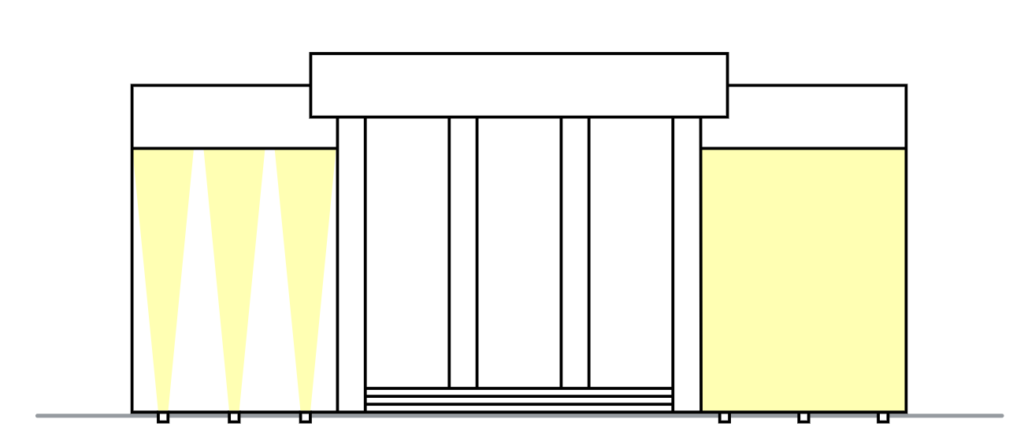
Vertical Divisions: Using narrow beam LED Spotlight strategically.
Using narrow beam LED Spotlight for facades with vertical divisions can enhance the effect of the vertical separations. To avoid shadows, the luminaires should be positioned strategically, ensuring that the direction of the light beam is parallel to the facade.
By employing LED Spotlight, you can create distinct vertical lines and emphasize the architectural elements of the facade. This technique adds depth and visual interest to the building’s exterior. Proper positioning and alignment of the luminaires are crucial to achieve the desired effect and avoiding any unintended shadows or uneven lighting.
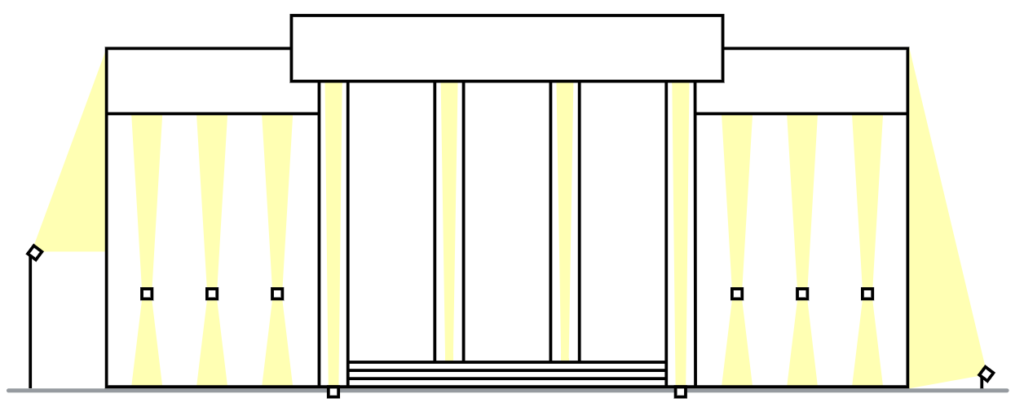
Horizontal Divisions: Accentuating with uplighting and linear fixtures.
When illuminating facades with horizontal divisions using uplighting (LED Flood Lights), placing the luminaires close to the facade can enhance the three-dimensional effect of the facade. By increasing the distance between the luminaires and the facade, you can minimize long and heavy shadows cast by the protruding parts of the facade.
In some cases, linear LED wall washers can be used to emphasize the horizontal divisions of the building. These fixtures can be installed along the horizontal structural elements of the facade, accentuating the building’s horizontal separations.
This combination of LED flood light and linear Led wall washer helps to highlight the architectural design of the facade, emphasizing both its vertical and horizontal elements. Careful placement and selection of lighting fixtures are important to achieve the desired visual impact and to ensure the facade’s features are properly showcased.
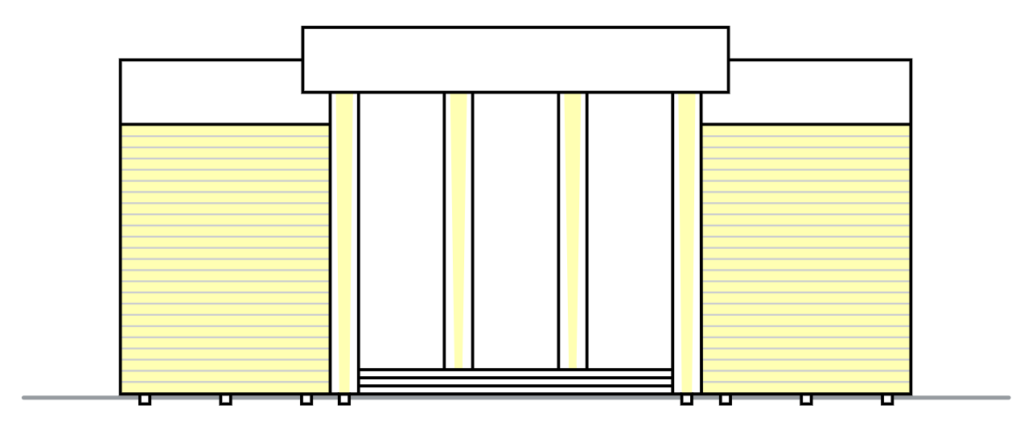
Concave and Convex Facades: Differentiated lighting for visual interest
When dealing with facades that have varying levels of concavity and convexity, it is generally recommended to use differentiated lighting with varying intensities or different light colors. This approach enhances the rhythmic quality of the facade’s appearance. However, using wide-angle lighting can diminish the contrast of the concave and convex elements, resulting in a flattened appearance of the building.
By employing differentiated lighting, you can highlight the unique architectural features of the facade and create visual interest. Using higher light intensities or warmer light colors on the convex portions and lower intensities or cooler colors on the concave portions can accentuate the depth and dimensionality of the facade. This technique emphasizes the play of light and shadow, adding a dynamic quality to the building’s exterior.
Proper consideration should be given to the placement and direction of the luminaires to ensure that the desired effects are achieved while avoiding any unintended shadows or uneven lighting. The goal is to enhance the aesthetic impact of the facade and create a visually captivating experience for observers.
Illuminating Facades with Windows: Enhancing Architectural Features
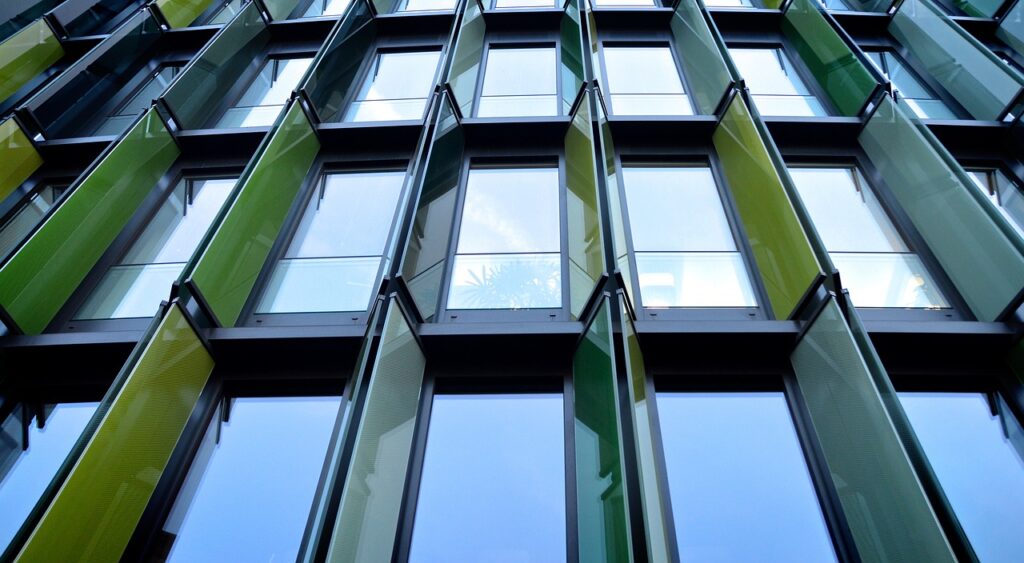
When illuminating facades with windows, it is important to consider that the lighting does not cause glare for occupants inside the building. Generally, highlighting the window frames or emphasizing the perimeter of the windows can enhance the architectural drama of the building.
To avoid glare, it is recommended to use lighting fixtures that are properly shielded and directed away from the interior spaces. This ensures that the light is focused on the window openings without causing discomfort or hindering the functionality of the building.
By accentuating the window frames or using lighting techniques that draw attention to the perimeter of the windows, you can create a visually striking effect. This approach highlights the rhythm and geometry of the facade, adding depth and visual interest to the building’s exterior.
Careful consideration should be given to the selection of appropriate lighting fixtures, their placement, and the control of light output to achieve the desired effect while maintaining a comfortable and visually pleasing environment for the occupants inside.
Different lighting approaches for building facade, design considers facade characteristics to enhance architectural features and visual impact.
The Impact of LED Facade Lighting
LED facade lighting has revolutionized architectural illumination, offering countless possibilities for enhancing the visual impact of buildings. With their versatility and energy efficiency, LED lights have become a popular choice for illuminating facades in various ways.
LED facade lighting allows for precise control over color, intensity, and patterns, enabling architects and lighting designers to create stunning visual effects. Whether it’s accentuating architectural features, highlighting vertical or horizontal divisions, or showcasing unique facade materials, LED lighting can transform the appearance of buildings and evoke a desired atmosphere.
Furthermore, LED lights offer flexibility in terms of dynamic lighting, allowing for changing colors and animated sequences. This dynamic lighting capability adds a new dimension of creativity to facade illumination, making buildings come alive and captivating viewers.
In addition to their aesthetic impact, LED lights are environmentally friendly and energy-efficient. They consume significantly less power compared to traditional lighting technologies, reducing energy consumption and carbon footprint.
The advent of LED facade lighting has brought about a new era of architectural expression, enabling buildings to become visually captivating landmarks. With their versatility, energy efficiency, and endless creative possibilities, LED lights have become an integral part of modern facade design, shaping the way we experience and appreciate architectural beauty.
Future Trends in LED Facade Lighting
LED facade lighting has transformed the way buildings are illuminated, offering enhanced aesthetics and energy efficiency. Looking ahead, several exciting trends are shaping the future of LED facade lighting.
Interactive Lighting:
- The future holds interactive LED facade lighting systems that respond to user input or environmental factors. Imagine facades that change colors based on crowd movements or adapt to weather conditions, creating immersive and dynamic visual experiences.
Integration with Smart Systems:
- LED facade lighting will seamlessly integrate with smart building systems. This integration will enable centralized control, allowing building operators to adjust lighting schemes, colors, and intensities remotely, optimizing energy usage and customization.
Sustainable Design:
- Environmental sustainability will continue to be a driving force. Future LED facade lighting solutions will focus on minimizing energy consumption, utilizing renewable energy sources, and incorporating smart lighting controls to achieve maximum efficiency and reduce environmental impact.
Artistic Expression:
- LED facade lighting will serve as a canvas for artistic expression. Innovations in LED technology will enable intricate lighting designs, pixel mapping, and the projection of custom animations, allowing architects and artists to create captivating visual displays on building facades.
Integration of Data and Sensors:
- LED facade lighting systems will integrate with data and sensor networks, enabling real-time information processing. This integration can lead to dynamic lighting responses based on factors such as pedestrian traffic, air quality, or user preferences, enhancing both aesthetics and functionality.
The future of LED facade lighting is bright, promising to revolutionize the way buildings are illuminated. With its versatility, energy efficiency, and potential for artistic expression, LED technology will shape the future of architectural lighting, providing remarkable visual experiences that leave a lasting impression.
Conclusion
LED facade lighting is a fascinating field that combines technology, design, and architecture to transform our urban landscapes. As we move towards a future where sustainability and interactivity become even more critical, LED facade lighting will continue to play a crucial role in creating captivating, efficient, and dynamic architectural designs. From selecting the right lighting technique to understanding the impact and future trends, this guide should provide you with a comprehensive overview of this intriguing subject.
